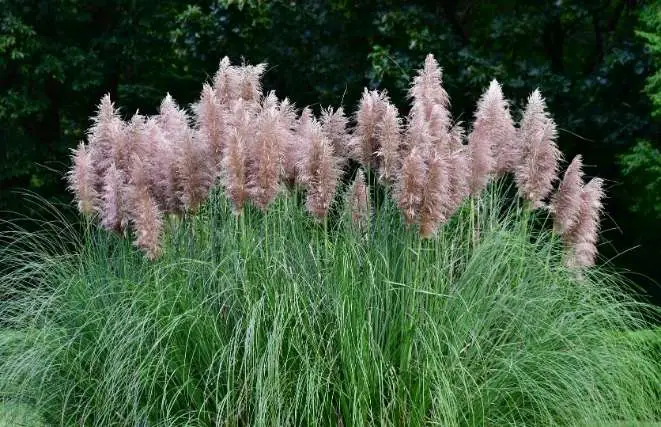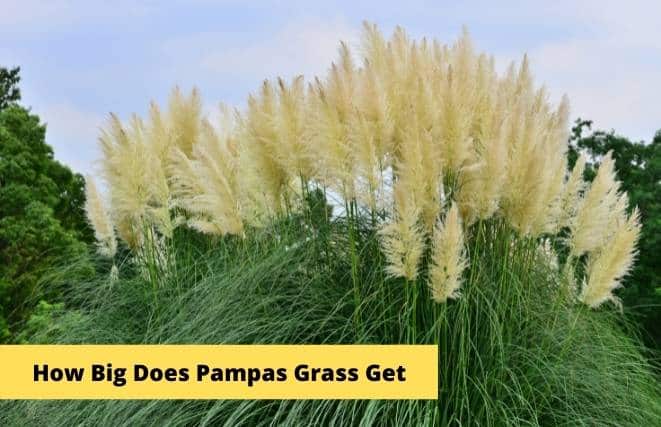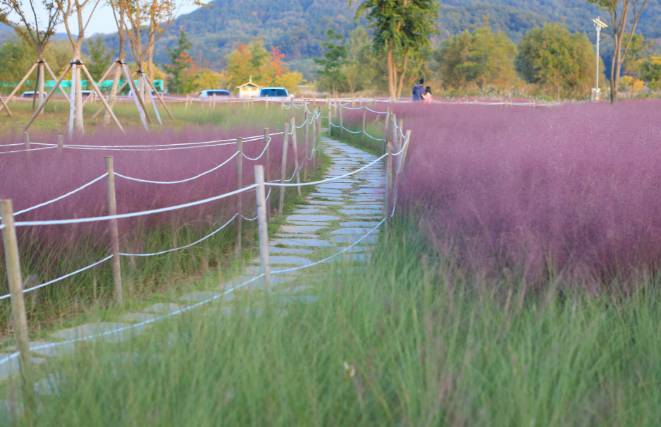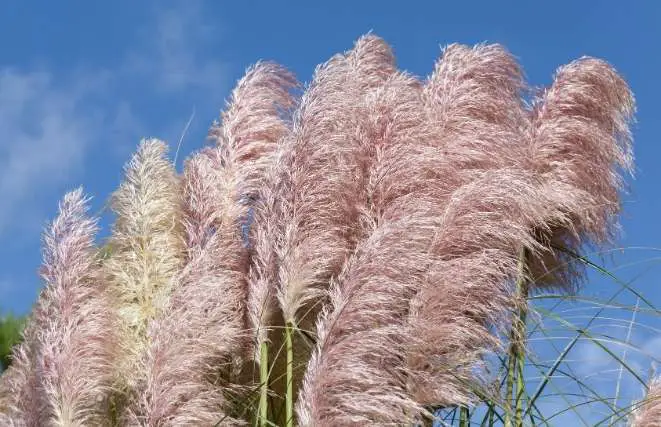Pampas grass is a popular ornamental grass that is known for its large size and striking appearance. It is native to South America, but it has become a common sight in gardens and landscapes around the world. One of the main reasons for its popularity is its impressive size, as pampas grass can grow up to 10 feet tall and 6 feet wide. However, the size of pampas grass can vary depending on several factors, such as the variety of the grass, the growing conditions, and how it is cared for.
There are several varieties of pampas grass, and they can grow to different sizes. The most common type of pampas grass is Cortaderia selloana, which can grow up to 10 feet tall and 6 feet wide. Another variety, Cortaderia jubata, can grow up to 12 feet tall and 8 feet wide. Some varieties, like the dwarf pampas grass (Cortaderia selloana ‘Pumila’), only grow up to 5 feet tall.
The size of pampas grass can also be influenced by the growing conditions. Pampas grass prefers full sun and well-draining soil. If it is planted in a shady or poorly draining area, it may not grow to its full potential. In addition, pampas grass is a warm-season grass and does not tolerate cold temperatures well. In areas with colder climates, pampas grass may not grow as tall or wide as it would in a warmer climate.
How Big Does Pampas Grass Get
Pampas grass can grow up to 10 feet (3 meters) tall and 6 feet (1.8 meters) wide, making it an impressive and dramatic addition to any garden or landscape. The size of pampas grass can vary depending on the growing conditions, including the climate, soil quality, and available nutrients. In general, pampas grass tends to grow larger in warmer, more humid climates with fertile soil.

Pampas grass is a warm-season grass that thrives in full sun and well-draining soil. It is known for its long, narrow leaves and showy, silvery-white or pinkish plumes that bloom in late summer or early fall. The plumes can grow up to 12 inches (30 cm) long and add a striking vertical element to any garden or landscape design.
What is Pampas Grass?
Pampas grass is an ornamental grass that is native to South America, specifically the pampas region of Argentina, Brazil, and Uruguay. It is known for its large size and feathery plumes, which make it a popular addition to gardens and landscapes around the world. Pampas grass can grow up to 10 feet tall and 6 feet wide, and it is characterized by its long, narrow leaves and showy, silvery-white or pinkish plumes that bloom in late summer or early fall.
Pampas grass has been cultivated for ornamental purposes since the 1800s, and it is often used as a specimen plant or as a backdrop in garden design. It is also used in dried flower arrangements and as a natural screen or windbreak. Pampas grass is a warm-season grass and prefers full sun and well-draining soil. It is relatively low-maintenance, requiring little watering or fertilization once established, but it does require regular pruning to keep it looking its best.
While pampas grass is a beautiful and popular addition to gardens and landscapes, it is also considered an invasive species in some areas, such as California and New Zealand. In these regions, pampas grass can spread quickly and outcompete native plants, leading to ecological problems. As a result, it is important for gardeners to be aware of the potential risks associated with planting pampas grass in certain regions and to take appropriate precautions to prevent its spread.
How to Grow Pampas Grass
Growing Pampas Grass (Cortaderia selloana) can be a rewarding addition to your garden, providing stunning plumes and attractive foliage. Here are some steps to successfully grow Pampas Grass:
- Choose the Right Location: Pampas Grass thrives in full sun, so select a location that receives at least 6 to 8 hours of direct sunlight per day. Ensure there is enough space for the grass to reach its full height and spread without overcrowding other plants.
- Prepare the Soil: Pampas Grass prefers well-draining soil with a slightly acidic to neutral pH. Amend heavy or clay soils with organic matter, such as compost, to improve drainage. Good drainage is crucial to prevent waterlogging, which can cause root rot.
- Planting: Plant Pampas Grass in spring or early summer when the soil has warmed up. Dig a hole slightly larger than the root ball and place the plant at the same depth it was growing in its nursery container. Backfill the hole with soil, and water thoroughly.
- Watering: Water newly planted Pampas Grass regularly to establish a strong root system. Once established, Pampas Grass is relatively drought-tolerant, but it still benefits from regular watering during prolonged dry spells.
- Pruning: In late winter or early spring, before new growth emerges, trim back the previous year’s growth to about 6 to 12 inches above the ground.
- Winter Protection: In colder climates, Pampas Grass may benefit from winter protection. Leave the plumes on the plant to provide some insulation to the crown. If you experience severe winter conditions, you can tie the foliage together and wrap the plant with burlap.
By following these guidelines and providing proper care, you can enjoy the beauty and grace of Pampas Grass in your garden for years to come.
Pampas Grass Varieties and Sizes
How big does pampas grass get? Well, this famous grass can also grow in different sizes depending on its variety.
- Cortaderia Selloana ‘Pumila’: Also known as dwarf pampas grass, it grows up to 6 feet tall and only 3 to 4 feet wide . It is perfect for indoor or room decors.
- Cortaderia Selloana ‘Sunningdale Silver’: This variety is the most common and it produces silver plumes and it grows up to 10 feet tall.
- Cortaderia Selloana ‘Rendatleri’: This variety can grow up to 8 feet tall and produces pink feathers-like plumes.
- Cortaderia Selloana ‘Andes Silver’: This variety can grow up to 7 feet tall and produces silvery white plumes.
- Cortaderia Selloana ‘Silver Comet’: This white-striped pampas grass can grow up to 8 feet tall.
- Cortaderia Selloana ‘Patagonia’: This variety can also grow up to 7 feet tall above foliage and produces silvery-white plumes and bluish gray-green foliage.
- Cortaderia Selloana ‘Gold Band’: This variety can also grow up to 6 feet tall and produces a golden-striped foliage.
- Cortaderia Selloana ‘Bertini’: This variety is almost the same as Pumila but it can grow up to 4 feet tall.
Importance of Pampas Grass to The Environment
- Due to its largeness, it is perfect for adding borders, living screen, and privacy to your gazebo, porch, garden, and backyard.
- Its toughness and aggressiveness are also ideal for areas near stream banks and places that are prone to soil erosion.
- However, it tends to propagate extremely fast and it can wipe out the whole native plants.
- Pampas grass has the ability to filter air pollution inside your house and other toxic chemicals that can affect your health.
- At night time, this plant converts carbon dioxide (CO2) into oxygen.
Frequently Asked Questions
Pampas grass can benefit from regular fertilization to promote healthy growth and the development of its characteristic showy plumes. The best fertilizer for pampas grass is a balanced, slow-release fertilizer with a ratio of 10-10-10 or 12-12-12.
When applying fertilizer to pampas grass, it is important to follow the manufacturer’s instructions carefully and avoid over-fertilization, which can lead to excessive growth and weaker plants. A general rule of thumb is to apply fertilizer in the spring and again in the fall, using about 1 pound (0.5 kg) of fertilizer per 100 square feet (9.3 square meters) of soil.
In addition to commercial fertilizers, organic fertilizers such as compost, aged manure, or bone meal can also be used to feed pampas grass. These natural fertilizers can provide nutrients to the soil and promote the growth of beneficial microorganisms, which can help improve soil health and plant growth.
Yes, pampas grass is considered an invasive plant species in some regions of the world, including parts of North America, Europe, and Australia. Pampas grass is a fast-growing, clump-forming perennial grass that can quickly outcompete native plant species and alter natural ecosystems.
Pampas grass can spread through its extensive root system, as well as by wind-blown seeds. Its sharp, blade-like leaves can also be a hazard to wildlife and humans alike. Because of its invasive nature, many jurisdictions have banned the planting of pampas grass and require its removal from natural areas.
In garden settings, pampas grass can be grown as a specimen plant or in large containers to limit its spread. If planting pampas grass in a garden or landscape, it is important to choose sterile cultivars that do not produce viable seeds and to prevent the plant from spreading to natural areas.
Conclusion
Pampas grass can grow up to 10 feet tall and 6 feet wide, but the size can vary depending on the variety, growing conditions, and maintenance. By understanding how to care for pampas grass and what factors can impact its size, gardeners can make informed decisions about how to incorporate this impressive grass into their landscapes.








